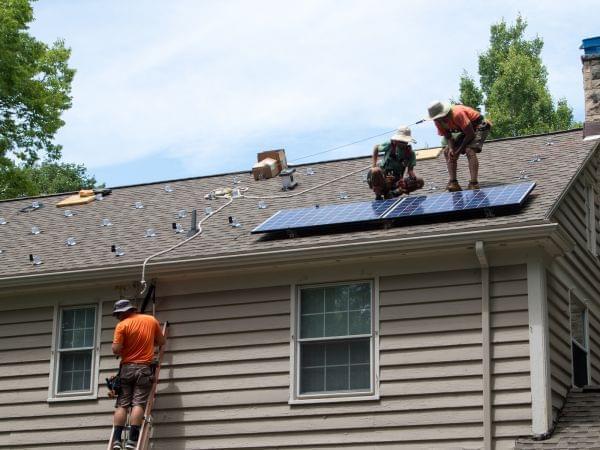Great strides for home solar thanks to Solar Urbana-Champaign program

Workers install the first of 25 panels on the author's roof. Rob Kanter
You may or may not remember it, but in a commentary last December spoke about my family’s plan to have solar panels installed on our Champaign home in 2016. I’m happy to report we followed through on that, and since late July have had 25 Hanwha Q-Cells up on our south facing, second-floor roof.
The system includes an online monitoring program, so I am able to say that up until now, our best day for energy production was August 6, when it generated 28.17 kilowatt hours of electricity. Our worst was August 15, with only 2.9 kWh generated—that was a gloomy day!
Although these numbers are meaningful to me now, they probably don’t do much to help you get a sense of how much electricity our system produces. Better, perhaps, to say that it’s expected to generate more than 80 percent of our total electricity use over the course of a year.
What’s more important than the fact that my family now has a solar array is that ours is one of 81 arrays that were (or are to be) installed at homes and businesses in Champaign County thanks to the Solar Urbana-Champaign Program.
Solar U-C, you might remember, was initiated by the Urbana Sustainability Advisory Commission, and intended to move the city forward on its Climate Action Plan, the ultimate goal of which is to reduce greenhouse gas emissions attributable to the community by 80 percent. The program secured a discount in the price for rooftop solar by bringing consumers together to buy as a group from a company selected through a competitive bidding process, St. Louis-based StraightUp Solar. StraightUp also partnered with local firm, New Prairie Construction, on some of the installations, including the one at our house.
On the subject of price, there are a few things you might be interested to know. The systems installed with the program averaged around $3.50/kw, which translates to $24,500 for an average size system. A federal tax credit returns 30 percent of that, though, and a state-sponsored program of renewable energy credits returns another 25 percent over five years, so the net present cost would be about $11,000.
Depending on electric use, assumptions about whether and how much electric rates will change in the coming years, etc., photovoltaic systems installed through the program are expected to pay for themselves in savings well within their lifespan.
Ultimately, of course, my family’s decision to go with solar power has more to do with our commitment to helping make renewable energy the norm in Illinois than saving money on our electric bill (although I’m not complaining about that, either). I also like the fact that much of the money we spent to bring electricity to our house in the coming years went to support good, local jobs.
If you participated in the Solar C-U Program, please know that the Illinois Solar Energy Association (ISEA) is looking for host sites for its annual Illinois Solar Tour, coming up on October 1. If you missed the Solar C-U Program but you’re still interested to explore home solar as an option, your best bet is to start with the vendors listed on the ISEA website at http://www.illinoissolar.org/iseabusinessmembers.

